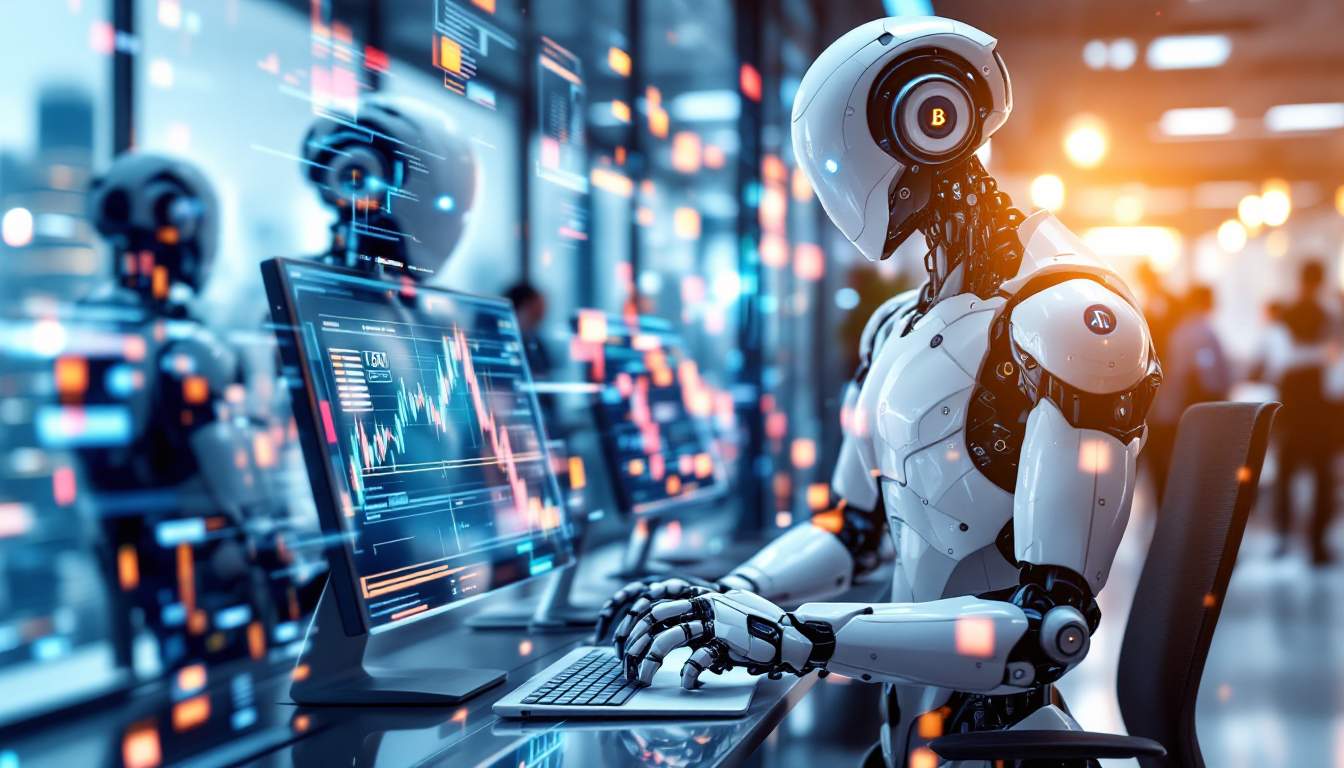User Tag List
Results 1 to 1 of 1
-
01-26-2025 #1Moderator


- Reputation
- 1
- Join Date
- Jul 2024
- Posts
- 2,652
- Thanks G/R
- 1/0
- Trade Feedback
- 0 (0%)
- Mentioned
- 0 Post(s)
- Tagged
- 0 Thread(s)
Crypto Gaming Meets AI: The Secret to Higher Profits in 2025
Crypto Gaming Meets AI: The Secret to Higher Profits in 2025

The fusion of blockchain gaming and artificial intelligence (AI) is reshaping the gaming industry. Crypto gaming has already disrupted traditional gaming paradigms by introducing decentralized finance (DeFi) and play-to-earn (P2E) models. Adding AI into this mix takes innovation to another level, providing new opportunities for gamers, developers, and investors to increase profits. This article explores how AI enhances crypto gaming and why 2025 marks a pivotal year for this revolutionary combination.

The Rise of Crypto Gaming
Crypto gaming leverages blockchain technology to offer decentralized and transparent gaming ecosystems. Players can own in-game assets, trade them freely, and participate in economies powered by cryptocurrencies. Some of the key components of crypto gaming include:
- Play-to-Earn (P2E): Players earn tokens or NFTs (non-fungible tokens) by participating in games, transforming gaming from a pastime into a revenue-generating activity.
- Ownership of Assets: Blockchain technology ensures players truly own their in-game assets, which can be sold or traded across platforms.
- Interoperability: Many crypto games allow players to use assets across multiple games, fostering a vibrant ecosystem.
- Decentralization: Developers and players interact directly, reducing dependency on intermediaries and lowering transaction fees.
Despite its massive potential, crypto gaming has faced challenges, including scalability, security, and user experience. This is where AI steps in.
The Role of AI in Crypto Gaming
Artificial intelligence brings advanced capabilities to crypto gaming, making the ecosystem more engaging, secure, and profitable. Here’s how AI is revolutionizing the space:
1. Enhanced User Experience (UX)
AI-driven algorithms analyze player behavior to deliver personalized gaming experiences. From tailoring difficulty levels to recommending in-game purchases, AI makes gameplay more engaging and enjoyable.
For example, AI-powered chatbots provide real-time customer support, while voice recognition systems enable immersive storytelling and interaction.
2. Smart NFT Integration
AI enhances NFTs by enabling dynamic, evolving assets. For instance, an AI-powered NFT character could learn and adapt based on a player’s actions, making it unique and valuable.
3. Fraud Detection and Security
Blockchain ensures transparency, but fraud and hacks are still prevalent. AI-driven fraud detection systems monitor transactions and gaming activities to flag suspicious behavior, protecting players and developers.
4. Game Development Optimization
AI accelerates game development by automating repetitive tasks like asset creation, bug detection, and quality assurance. AI tools like procedural content generation allow developers to design expansive, detailed game worlds efficiently.
5. Play-to-Earn Optimization
AI optimizes tokenomics—the economic models of crypto games—to ensure sustainability. Predictive analytics help developers balance token supply and demand, preventing hyperinflation and ensuring long-term profitability.
6. Adaptive Monetization Strategies
AI algorithms analyze market trends and player behavior to suggest monetization strategies. For instance, dynamic pricing models for NFTs and in-game assets can maximize revenue by aligning with market conditions.
How AI-Driven Crypto Gaming Increases Profits
Integrating AI with crypto gaming boosts profitability for all stakeholders—players, developers, and investors. Here’s how:
For Players:
- Higher Earnings: AI-driven game balancing ensures fair P2E opportunities, allowing more players to earn rewards.
- Asset Appreciation: AI enhances the uniqueness and value of NFTs, increasing their market demand.
- Time Optimization: AI-powered bots assist players in automating repetitive tasks, improving efficiency and productivity.
For Developers:
- Cost Efficiency: AI tools reduce development costs by automating workflows and streamlining testing processes.
- Engagement Retention: Personalized experiences keep players engaged, boosting retention rates and revenue.
- Fraud Reduction: AI strengthens security, reducing financial losses from fraud and hacks.
For Investors:
- Informed Decision-Making: AI-driven analytics provide real-time insights into market trends, guiding better investment decisions.
- Portfolio Diversification: Dynamic NFTs and AI-powered games offer innovative investment opportunities with high ROI potential.
- Market Scalability: AI enhances scalability by optimizing blockchain operations, ensuring the ecosystem can handle increasing demand.
Real-World Examples of AI in Crypto Gaming
1. Illuvium
Illuvium, a blockchain-based RPG, leverages AI to create intelligent in-game characters and NPCs (non-player characters). These characters adapt to player strategies, offering a dynamic and challenging gaming experience.
2. Axie Infinity
Axie Infinity uses AI to balance its P2E model and predict token price fluctuations. By optimizing tokenomics, the game ensures long-term sustainability and profitability for its players and investors.
3. Gala Games
Gala Games incorporates AI in procedural content generation, enabling developers to create immersive, expansive game worlds without manual input.
Challenges and Solutions
While the synergy of AI and crypto gaming is promising, it comes with challenges:
1. Scalability
AI-powered systems require significant computational resources, which can strain blockchain networks. Layer-2 scaling solutions and decentralized AI platforms can address these issues.
2. Data Privacy
AI relies on large datasets, raising privacy concerns. Privacy-preserving AI techniques, such as federated learning, ensure data security without compromising functionality.
3. Regulatory Hurdles
The legal framework for AI and crypto gaming is still evolving. Collaboration between developers, policymakers, and regulators is crucial to create a conducive environment.
Future Trends to Watch in 2025
- AI-Powered Metaverse Gaming: The metaverse is set to become the next frontier in gaming, and AI will play a central role in creating immersive, interconnected virtual worlds.
- Dynamic NFTs: NFTs that evolve based on player interactions or AI algorithms will dominate marketplaces.
- DeFi Integration: Advanced AI systems will integrate decentralized finance into gaming, offering players innovative financial products like staking and lending.
- Sustainability Initiatives: AI will optimize energy use in blockchain networks, addressing environmental concerns.
- Cross-Chain Interoperability: AI will facilitate seamless asset transfers across multiple blockchains, expanding the gaming ecosystem.
Conclusion
The convergence of crypto gaming and AI marks a paradigm shift in the gaming industry. By addressing challenges and maximizing opportunities, AI-driven crypto games offer unprecedented profit potential for all stakeholders. As 2025 unfolds, this synergy will not only redefine gaming but also set the stage for a more decentralized, intelligent, and profitable future. Whether you’re a gamer, developer, or investor, now is the time to embrace the possibilities of AI-powered crypto gaming—because the future is already here.
Similar Threads
-
The Ultimate Guide to Profiting in Crypto Gaming with AI Strategies
By Seithtanveer in forum CasinoReplies: 0Last Post: 01-26-2025, 01:14 AM -
The Future of Crypto Gaming: Leveraging AI for Maximum Earnings
By Seithtanveer in forum CasinoReplies: 0Last Post: 01-26-2025, 12:30 AM -
Unlocking the Future of Crypto Games: Top AI Features in 2025
By Seithtanveer in forum CasinoReplies: 0Last Post: 01-24-2025, 04:26 AM -
Discover the Secret to Success with Bitcasino's Latest Bonuses
By Seithtanveer in forum CasinoReplies: 0Last Post: 01-14-2025, 07:28 AM -
[Tutorial] Diablo III game online on the 28th to repair the fall to raise the overall
By Yeung89 in forum Diablo 3 GeneralReplies: 2Last Post: 07-18-2012, 09:49 PM















 Reply With Quote
Reply With Quote







